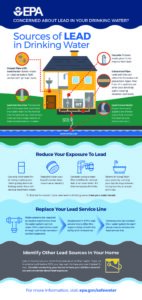Lead and Copper Facts
Updated: 07/2024
EPA :: Lead and Copper Facts
Sources of Lead in Drinking Water
EPA’s infographic regarding lead in drinking water:
Learn basic information about sources of lead in drinking water, suggestions for reducing exposure and information about replacing lead service lines.
On December 22, 2020, U.S. Environmental Protection Agency (EPA) finalized the first major update to the Lead and Copper Rule (LCR) in nearly 30 years. EPA’s new rule strengthens every aspect of the LCR to better protect children and communities from the risks of lead exposure. The new LCR will better protect children at elementary schools and child care facilities, get the lead out of our nation’s drinking water, and empower communities through information. View the LCRR Fact sheet published by EPA.
Lead is very dangerous to human health. For children, lead exposure can cause irreversible and life-long health effects, including affecting IQ, focus, and academic achievement. Drinking water is a potential source of lead in homes.
The EPA offers a guide that will help you determine if you have a lead service line bringing water into your home. It uses pictures, step-by-step directions to identify lead service lines, provides tips to reduce lead exposure, information on testing your water, and resources to learn more. Try this Interactive Guide that can assist homeowners in identifying likely lead service lines in the home.
Here is a link to review the current LDWA MAP: Customer Service Line Data
How Lead Gets Into Water
Lead in drinking water most often comes from water distribution lines or household plumbing rather than from the water system source. Plumbing sources can include lead pipes, lead solder, faucets, valves, and other components made of brass. Lead from other sources (such as lead-based paint and contaminated dust or soil) can increase a person’s overall exposure, which adds to the effects of lead in water.
Potential Health Effects of Lead
The greatest risk of lead exposure is to infants, young children, and pregnant women. Lead can cause serious health problems if too much enters the body. Lead is stored in the bones and can be released later in life. Lead can cause damage to the brain and kidneys, interfere with production of red blood cells that carry oxygen, and may result in lowered IQ in children. During pregnancy, the child receives lead from the mother’s bones, which may affect brain development. Low levels of lead can affect adults with high blood pressure or kidney problems.
How Copper Gets Into Water
Copper is a mineral and natural component in soils. In the correct amounts, it is an essential nutrient for humans and plants. In Utah, most copper in drinking water comes from corrosion of household plumbing. Plumbing sources can include copper pipe and brass fixtures. Copper from plumbing corrosion can accumulate overnight.
Potential Health Effects of Copper
Although copper is an essential mineral in the diet, too much copper can cause health problems. Copper is widely distributed within the tissues of the body, but accumulates primarily in the liver and kidneys. A single dose of 15 mg of copper can cause nausea, vomiting, diarrhea, and intestinal cramps. Severe cases of copper poisoning have led to anemia and to disruption of liver and kidney functions. Individuals with Wilson’s or Menke’s diseases are at higher risk from copper exposure.
How you can reduce exposure:
- When your water has been sitting for several hours, flush the pipe by running the cold-water tap until the water is noticeably colder before using the water for drinking or cooking. (The longer water has been sitting in the pipes, the more dissolved metals it may contain).
- Use only cold water for drinking, cooking, and making baby formula. Hot water may contain higher levels of lead or copper.
- Frequently clean the filter screens and aerators in faucets to remove captured particles.
- If building or remodeling, only use “lead free” or low lead piping and materials. Avoid using copper piping or brass fixtures for locations where water will be consumed or used in food preparation (such as kitchen or bathroom sinks).
TESTING YOUR WATER
There are a number of Certified Water Testing Labs you can find by doing a simple search on the internet.
The LDWA currenlty has all it’s testing by a firm named: CHEMTECH-FORD LABORATORIES
A number of online, mail-in, water testing firms have become available. Here are some to research.
[ TAP SCORE | ETR LABS ] Also many spa & pool companies offer testing for PH, and hardness.
